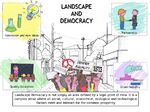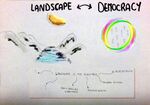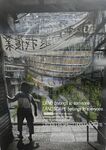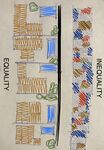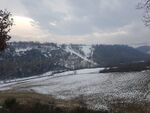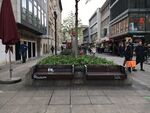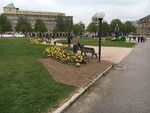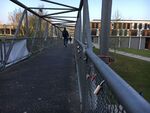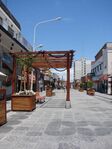LED Online Seminar 2019 - Working Group 2
--> Back to working group overview
Dear working group members. This is your group page and you will be completing the template gradually as we move through the seminar. Good luck and enjoy your collaboration!
Assignment 1 - Reading and Synthesizing Core Terminology
- You can read more details about this assignment here
- Readings are accessible via the resources page
Step 1: Your Landscape Democracy Manifestoes
Step 2: Define your readings
- Please add your readings selection for the terminology exercise before April 24:
A: Landscape and Democracy
Burckhardt, Lucius (1979): Why is landscape beautiful? in: Fezer/Schmitz (Eds.) Rethinking Man-made Environments (2012) [Nicole]
The New Urban Agenda, Quito Declaration on Sustainable Cities and Human Settlements for All, UN resolution from December 2016 [Giulia]
(IFLA-Europe) Landscape Democracy Resolution [Vicky]
B: Concepts of Participation
Burckhardt, Lucius (1974): Who plans the planning? in: Fezer/Schmitz (Eds.) Rethinking Man-made Environments (2012) [Nicole]
Sanoff, Henry (2014): Multiple Views of Participatory Design, Focus [Javier]
C: Community and Identity
Francis, Mark: A Case Study Method for Landscape Architecture [Nicole]
Welk Von Mossner, Alexa (2014): Cinematic Landscapes, In: Topos, No. 88, 2014. [Giulia]
Hester, Randolph (2006): Design for Ecological Democracy, The MIT Press [Javier]
D: Designing
Hester, Randolph: Life, Liberty and the Pursuit of Sustainable Happiness [Giulia]
Kot, Douglas and Ruggeri, Deni: Westport Case Study [Vicky]
E: Communicating a Vision
Boer, Florian, Jens Jorritsma, and Dirk van Peijpe. 2010. De Urbanisten and the wondrous water square. Rotterdam: 010 Publishers. Webpage and Video. [Javier]
Online toolbox with the most important engagement tools and their descriptions. https://www.publicengagement.ac.uk/do-it/techniquesapproaches [Vicky]
Steps 3 and 4: Concepts Selection and definition
- Each group member selects three relevant concepts derived from his/her readings and synthesize them/publish them on the wiki by May 15, 2019
- Group members reflect within their groups and define their chosen concepts into a shared definition to be posted on the wiki by June 12, 2019.
- Other group members will be able to comment on the definitions until June 30, 2019
- Each group will also report on their process to come to a set of shared definitions of key landscape democracy concepts on the wiki documentation until July 12, 2019
Concepts and definitions
Author 1: Giulia Gazzotti
- #NewUrbanAgenda: cultural diversity is a resource for humanmankind; cities for all; equal rights and opportunities; equal pay for equal work; protect and conserve the biodiversity; link people, places and goods; leave no one behind
- #Wrongside: the landscape is used to express the racial, gender and economic power dynamics
- #Wearelost: resources convey status and have become a primary basis of our personal identity and security; no community connection; sustainability will require us to reformulate our society; cities need to be fair with their past and history; create large spaces where we can live and buildings that are able to touch our spirit and enrich our lives; active participation
'Author 2: Ho Ching Leung (Nicole)
- #ParallelogramOfForcesInPlanning: lies between officials in power, construction industry speculators, civic stakeholders and people affected by the measures undertaken. Decision-makers are to hem technical planning in two sides, on one side by democratizition and participartion, and on the other side on technocratic terms. (Burckhardt, Lucius (1974): Who plans the planning? in: Fezer/Schmitz (Eds.) Rethinking Man-made Environments (2012))
- #CaseStudyMethod: A case study is a well-documented and systematic examination of the process, decision-making and outcome of a project, which is undertaken for the purpose of informing future practice, policy, theory and education. It is useful in retaining holistic and meaningful characteristics of real life situation and can be applied in participatory planning. Six major potential benefits of case studies include teaching, research, practice, theory building ,criticism and communication and outreach. Methodologies of case study vary case by case but a simple example illustrated starts off by outlining basic information of the project, context, history, site analysis, genesis of the project, role of landscape architects in the project, maintenance and management, user analysis, limitations, future issues, recommendations and implications, and future research issues. (Francis, Mark: A Case Study Method for Landscape Architecture)
- #
Author 3: ...
- ......
- .......
- .......
Author 4: ...
- ......
- .......
- .......
Step 5: Reflection
Step 6: Revised manifestoes
- please look again at your initial manifestoes and update them with any new aspects/prespectives you have taken up during this seminar
Assignment 2 - Your Landscape Symbols
- You can read more details about this assignment here
Landscape Symbols Author 1: Vicky Moreno
The Salamander Stadtpark is located in the center of Kornwestheim, across the City Hall. The historical and cultural meaning of the Salamander Enterprise donation for the creation of this park is huge, with some statues and inscriptions all over the park, inviting you to search the history of Kornwestheim more. The symbolism of this act is obvious. Salamander contributed to innovation giving thousands of working spaces, increasing the economy of the district, creating green infrastructure and its actions have an impact to the citizens till today.
Salamander Stadtpark in Korwestheim owns an artificial lake. The three landscape elements of this park: water, meadow and woodland are creating an interesting contrast in a harmonious way of nature. But especially water as a vivid element, has a very special quality in landscape design. Depending on the season it is representing freedom, family values, cultural and well-being activities, and more or less the feeling of equality. In winter when the lake freezes, in the eyes of many, prevails a harmonic sense of peace. In conclusion, water in the landscape is viewed as a symbol synomymous with development, economic progress, modernization and national prestige.
This sculpture, located at the roundabout on Stuttgarterstraße and Lindenstrasse, in the entrance of Kornwestheim city, was created to honor the mechanical clergyman and genius Philipp Matthäus Hahn and it symbolizes the cohesion among all the different sciences and spirituality. Only with strong fundamentals can someone innovate, create and invent for the public and not only for personal profits.
Landscape Symbols Author 2: Giulia Gazzotti
The last picture is from Lund, Sweden, the place of my exchange for five months. I named it "Efficiency", because in Sweden, differently from my country, public things, paid with public money, work perfectly. The conclusion is that Democracy gives the chance to culture and people to express theirselves freely in the landscape and this is clearly shown in the three pictures. They are the proof of a completely different result on which we should reflect.
Landscape Symbols Auther 3: Nicole (Ho Ching Leung)
(48° 46' 30.732" N 9° 10' 40.068" E) Photo was taken in Schlossplatz, in the open space in one of the busiest shopping streets in Stuttgart. The landscape symbol identified is the graffiti on benches. Graffiti is not only perceived as a hip-hip culture but also a way for youngsters to express their opinions to the society in recent decades. It is a symbol of the integration of social democracy and public space.
(48° 46' 42.582" N 9° 10' 42.912" E) Photo was taken in Schlossplatz, Stuttgart. The photo symbolises human control over nature. Parts of the existing lawn were replaced with decorative flower beds as visual attractions to celebrate the upcoming Easter. It not only reflects the role of landscape in cultural celebrations, but also human’s manipulation to nature, questioning the degree of democracy of the landscape itself.
(48° 44' 42.588" N 9° 6' 9.34" E) Photo was taken in University of Stuttgart. The photo reflects how different users perceive the same piece of landscape and give different symbolic meanings to it. This bridge with love-locks might be a romantic place for couples but just a normal bridge for single people. It reflects that the unique symbolic meanings of each landscape subject to users’ definitions and perceptions.
Landscape Symbols Author 4: Javier (Tirone)
I live in Pilar, Buenos Aires, Argentina. It is a place where the contrast between classes is notorious. This first picture shows a higher class family who has private security and amenities. This symobolizes how a big part of the society is excluded, by these private neighbourhoods, due to their incapacity of affording these services.
Reflection
- ....
- ....
- ....
Conclusion:
- ....
- ....
- ....
Your references
- ...
- ...
- ...
